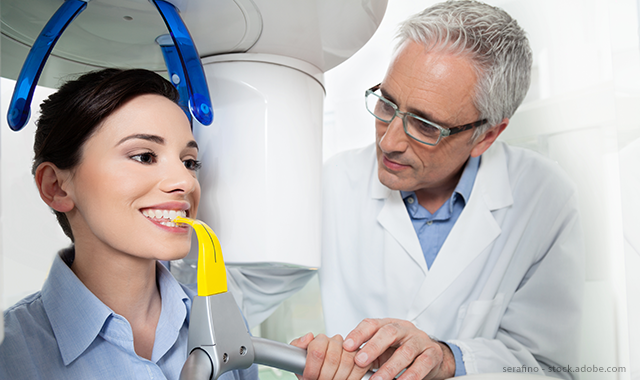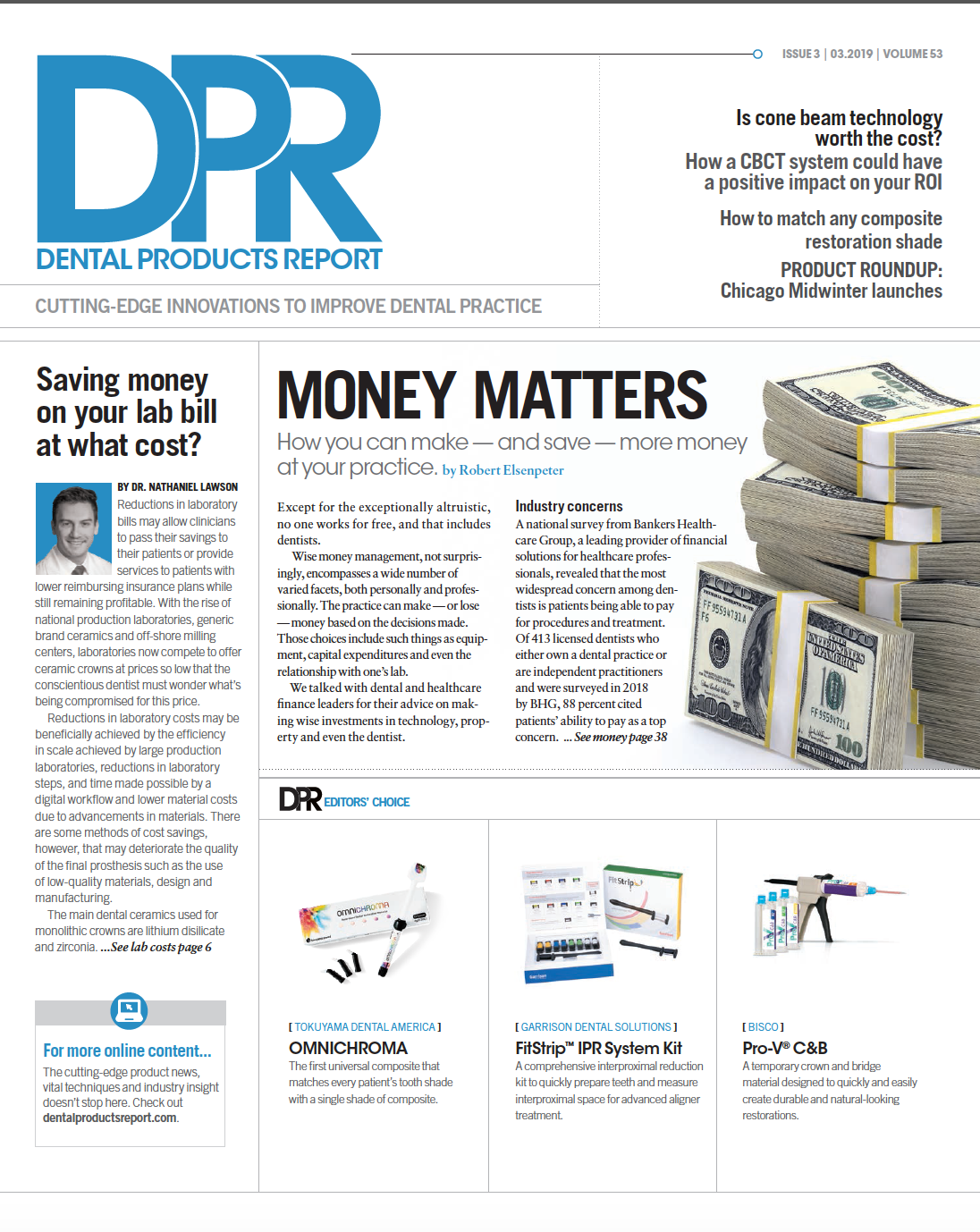Is cone beam technology worth the cost?
Learn how a CBCT system could have a positive impact on your ROI and practice scope.

A ccording to the FDA, cone beam CT systems have important roles in many dental subfields, including implants, endo, ortho and sleep breathing disorders. But is the major cost of a CBCT system (usually valued between $80,000 and $120,000) worth it?
John Flucke, DDS, says yes.
“Cone beam makes things more efficient, so you can treatment plan better,” says Dr. Flucke, chief dental editor and technology editor for Dental Products Report. “Things are easier with fewer unexpected outcomes. It also keeps you out of legal trouble because there are cases in which someone has been sued for an implant gone awry. A good attorney will want to see a cone beam scan right away.”
It’s not all about fear, though. He predicts that the combination of a cone beam scan and bitewing images will become the norm within 10 years as a consequence of the information cone beam scans provide.
Trending article: How to eliminate dental patient phobias
For those dentists who want to get ahead of the curve, the cost is often the first hurdle. That said, it can be managed.
Managing the cost
A CBCT scanner is just about the most expensive piece of equipment a dental practice could purchase, aside from an in-office milling system. Dr. Flucke won’t argue that the ROI is going to be substantial or immediate, but it will be there.
He speculates that it takes about three years for dentists to recoup their investment on a CBCT scanner, but for those who aren’t ready for the financial commitment, sending patients to get a scan at another practice is also an option. In fact, that’s what Dr. Flucke’s practice does for many external patients. “The patients walk in, fill out their health history, get a scan, write a check and leave, and we send the CD of the scan to their dentists,” he says.
“A lot of people will say that putting a cone beam in your practice will make you a lot of money. I don’t know if I necessarily agree with that, and I’m not really about doing something just to make more money, but I do love efficiency. If you could do something in 30 minutes instead of an hour, why wouldn’t you? It decreases stress on everybody.”
Broadening the scope of practice
Dr. Flucke doesn’t stand behind doing something just for the money, but he can get behind broadening one’s scope of practice. He credits a CBCT scanner as the reason his practice is able to place implants and treat patients with sleep-disordered breathing.

“It’s also great for orthodontics, endodontics and pathologies in general,” Dr. Flucke says. “If someone comes in with something strange on an X-ray or they have a strange complaint in general, you can take a scan and either find or eliminate situations with them.”
Treating sleep breathing disorders is one of the most interesting trends that has popped up in dentistry lately. With so much talk about the oral-systemic link, it’s encouraging to see dentists and medical doctors working together so closely on an issue that silently plagues so many Americans. (Or not so silently, if that patient snores!) While dentists aren’t allowed to diagnose sleep apnea, giving them the resources they need to get their patients diagnosed by a medical doctor is a literal life-saving idea. That’s what SleepArchiTx, Dr. Flucke’s partner in treating sleep-disordered breathing, does.
Read more: The best tech to enhance your practice
Because dentists are often the first step in identifying possible breathing issues in patients, SleepArchiTx provides online training to dentists that enables them to identify risk factors and symptoms of sleep disordered breathing in their patients, then connects those dentists with physicians who can diagnose breathing disorders and suggest the most appropriate treatment modalities for those patients. Dr. Flucke uses Anatomage software on his CBCT to analyze patients’ airways for constrictions and other issues, and then utilizes tools from SleepArchiTx to help treat those patients.
“When you do a sleep study, SleepArchiTx provides the hardware that the patient wears at home, then they analyze the study and the cone beam that you send them,” Dr. Flucke explains. “The doctor that does the analysis then makes recommendations on the best treatment appliances for that particular patient’s clinical situation. They really do a lot of work in the background. You take the impressions, you have the device fabricated and fitted, and that’s kind of it.”
Dr. Flucke adds that the follow-up the patients receive is a huge benefit.
“When people go to the doctor and get a CPAP, that’s the end of it,” he says. “Nobody follows up and sees that it’s working. And SleepArchiTx makes sure it’s working.”
Dr. Flucke does multiple sleep studies with his patients: one at the beginning of treatment, one in the middle and one at the end to make sure that the appliance prescribed is actually helping the patient.
“Sixty percent of the people who are given a CPAP mask aren’t wearing it a year later. What is the point of treating a disease process if nobody knows if the patients get better?”
Continue to page two to read more...
Increasing reimbursements
Because SleepArchiTx treats sleep-disordered breathing like the medical disease it is, they can bring in the medical insurance with it.
“It’s important for dentists to be aware that reimbursements are higher if you bring in the medical side, and that’s one of the things that SleepArchiTx brings to the table,” Dr. Flucke says. “Dentists don’t want or need to go out and reinvent the wheel to figure out how to code it and all of that.
“It’s a turnkey system,” he continues. “The dentist does their part in dentistry, then they turn it over to them so that they can get the diagnosis, have the sleep studies read by a sleep physician, submit to medical insurance and everything else. When all of the billing is taken care of, the reimbursement comes back to the dental practice. Because SleepArchiTx helps get medical insurance to pay for it, the dental patient’s out-of-pocket remains pretty low. You can get into multiple thousands of dollars being reimbursed. They do all of the behind-the-scenes stuff that we dentists can’t and won’t do anyway.”
Trending research: Is there a bidirectional link between periodontitis and diabetes?
Analyzing and utilizing data
Many dentists think having more data means putting themselves at risk.
“A lot of people aren’t trained to read the scans,” Dr. Flucke says. “Some people are afraid that if they have all this information and they don’t know how to read it, there will be some pathology on the scan that they don’t notice. Something could happen down the line and an attorney can come back and say that it’s been there the whole time and the dentist didn’t do anything about it.”
Luckily, there exists what Dr. Flucke calls a “get-out-of-jail-free card”; radiologists who can read them for you, at around $50 to $70 per scan.
“If you go to a hospital and an ER doctor orders a CAT scan, they aren’t the one who’s going to spend an hour going over it,” he says. “It’s going to be a radiologist that looks at it in real time. That’s their job. Dentists get hung up on being the doctor who has to do it all, but it’s not your responsibility.”
We know that having cone beam CT scans opens up a world of possibilities now, but who knows what the data will be able to offer in the future. At the very least, it could provide a baseline for your patients to help you make predictive judgments.
“The longer your patients stay in your practice and the more data you have on them, the better you’ll be at predicting what’s going to happen to their teeth in the future,” Dr. Flucke says. “If you have a baseline of your patients, you’ll know which ones need intervention and which ones don’t.”
The benefits are there for everyone, no matter what level of commitment or involvement you want to take. You can send patients to another practice to get the scans and then send those scans to a radiologist for interpretation, or you could purchase the equipment yourself and learn how to read the scans. Either way, the data is available for any dentist to begin to widen their scope of practice. If you do decide to bite the bullet, Dr. Flucke advises choosing a system with the best image quality and ease of use of software at your price point.
